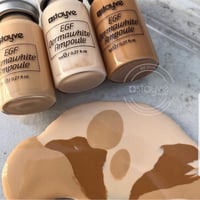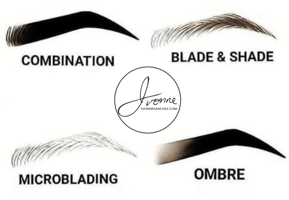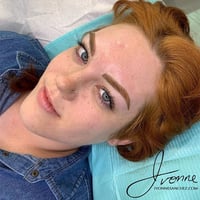We no longer offer this treatment. This article is for information purposes only.
Should I Get Micro-Needling or Laser Treatment?
At IVONNE, we realize that beauty treatments are trendy and there is always something new to try. To support our clients, we maintain a skeptical posture over the products and services that we offer. We “interview,” question and re-question every product and service that we offer, knowing that information changes over time. If something doesn’t seem right – we’re out.
Should I get microneedling, fibroblast, platelet-rich plasma (PRP) or laser treatment?
When making decisions about how to treat our skin, it is better to make those decisions based on good information and from multiple sources.
A quick (very high level) look at the skin:
1. Epidermis:
This is the top layer of skin that you can see right now. This is the layer of skin that we apply skin products.
2. Dermis:
This is the middle layer of your skin, where the important functions of your skin take place. This layer is nearly inaccessible from either above or below. This is the layer where pimples are formed. This is also the layer where pigments are deposited during microblading procedures. The dermis contains among many things:
-
Collagen that keeps your skin strong and together
-
Elastic fibres, to make sure that your skin returns to shape
-
Lymphatic and blood vessels
3. Subcutaneous tissue
(hypodermis – the bottom layer): This connects your skin to your body with connective tissue, muscle and fibres. This is your skins’ foundation.
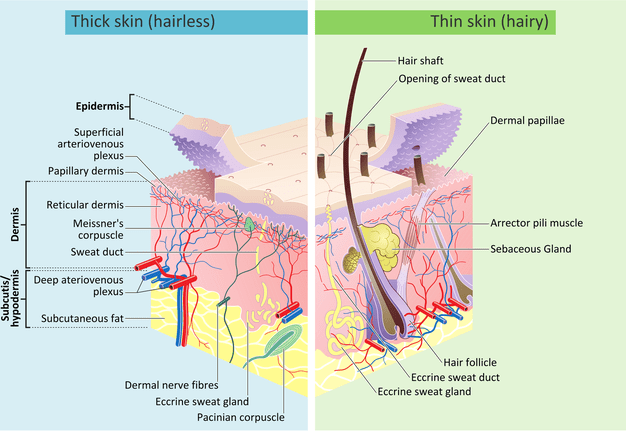
It is understood that whatever is going on in the dermis layer impacts what appears at the epidermis layer. We can conceal, treat and pamper the outer layer of skin, but if the dermis is not healthy or supported, it only treats the external. In other words: an exercise in futility when it comes to bringing about lasting healing change and protection against ageing.
Why most topical cosmetic serums and moisturizers are not as effective and target the superficial skin layer
Many, if not all, over the counter consumer serums and moisturizers, are regulated such that they are permitted to treat only the top layer of the skin – the epidermis. Many regulatory bodies restrict cosmetic topical skin products from working within the second layer, the dermis. What happens in the dermis impacts the appearance of the epidermis. By not reaching the dermis, this is a missed opportunity to bring about reversed ageing or protect against ageing.
It is necessary and more effective to get into the dermis with microneedling. Microneedling aims to treat the dermis and to make available growth factors for the dermis to get nourishment. Through microneedling, this makes thousands of pin-holes into the epidermis that allow us to introduce growth factors, namely Cytokines, for reach and absorption by the dermis.
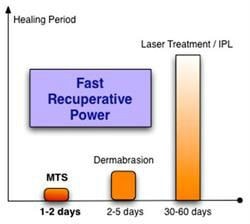
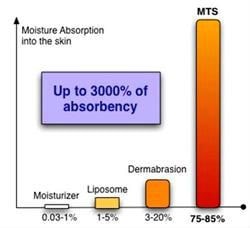
What is microneedling?
Microneedling is tightening, lifting and rejuvenating the skin through collagen activation. Optimally, this procedure is performed with an approved “pen” with disposable needle cartridges. The pen is gently pressed into the skin (starting at a depth of about 0.5mm) in “hash-tag” swiping patterns encouraging the breakdown of undesired sunspots, promoting collagen production and healing to rid the skin of fine lines and wrinkles.
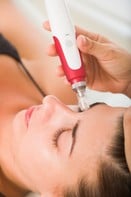
What is microneedling with Ivonne Sanchez?
It is world-class Collagen Induction Therapy, a unique blend of microneedling combined with AnteAGE stem cell Cytokine serum and moisturizer. Cytokines (bio-signals harvested from human bone marrow) are introduced into the skin layers through many microscopic pinpoints, allowing the skin’s dermal layer to benefit from proteins that promote skin healing unlike any other treatment.
Certified Microneedling professionals
Certified professionals have access to specialized equipment that is not readily available for consumer purchase. In our clinic we use Eclipse Pen, a Health Canada Approved Class 2 Medical microneedling device that tightens and rejuvenates the skin. Effectively reducing fine lines and wrinkles, pores and stretch marks; keloid, surgical and acne scars. Our unique spring-loaded needle tip uses automatic vibrating stamp-like motions that enhance results and offer a more controlled and safer treatment method than other microneedling devices.
Our use of patented pens comes with disposable single-use microneedling tips, and they come in sterilized individual packages that are easily replaced. The pen has 12 stainless steel microneedles that can be adjusted from 0.5mm to 2.5mm giving practitioners an innovative tool to help clients achieve desired results. The depth can be adjusted according to the different treatment areas. Deeper is not always better, and in fact, less is more. This pen can easily manoeuvre facial contours and delicate features like eyes, nose and mouth.
A certified professional will know that your treatment should not result in a scary blood-facial, but instead, you should see only a few pinpoint blood spots appearing over the face as the treatment is underway. More pinpoint blood spots are an indicator that the treatment is too deep and is causing needless inflammation.
Is microneedling, and microneedling with Cytokines safe?
Microneedling, if practiced by a trained professional adhering to the safety standards and best practices, is very safe. It is the most effective treatment with the most minimal amount of discomfort, healing time and risks. Cytokine growth factors are very safe and the products are subjected to a rigorous testing and screening process. The microneedling practice is not a medical procedure, and is not identified as a “controlled act” under The Regulated Health Professions Act, 1991, S.O. 1991, c.18 Section 27. For more information about medical procedures please consult with the College of Physicians and Surgeons.
Why You Should AVOID Fibroblast Plasma Skin Procedures AND Instead CHOOSE Microneedling
Fibroblast plasma skin procedures are new within the realm of beauty services. They are quickly becoming popular among those seeking skin improvements.
This treatment broadly and indiscriminately targets unknown tissue to get rid of excess skin, wrinkles and other unwanted skin imperfections. The process encourages needless inflammation, lacks supporting treatment to ensure healing and assumes that the body’s collagen and fibroblast reserves will produce the proper outcome. It is well understood that the body, as it ages, is less capable of creating collagen and is less able to respond to healing demands as readily. Fibroblast Plasma procedures may cause unnecessary demands on the body cannot cope with, without proper support post-treatment. As this treatment is still new within North America, we strongly urge you to consult with a physician before considering any skin treatments, and Fibroblast Plasma is no exception. Further, the treatment is promoted without readily available science-backed documentation that would support what exactly the process does, what skin changes are occurring, and what healing, if any, actually takes place (over the possibility that it is simply leaving behind inflammation and swelling as a method of producing ‘changed skin’). Based on the research, if this treatment is intended to inspire fibroblasts to support change or healing, it is established that the impact of fibroblasts is quite feeble compared to mesenchymal stem cell cytokines.
Why You Should AVOID Laser Therapy AND Instead CHOOSE Microneedling
COST: We don’t shy away from the cost of high-quality treatments, and we do say that “you should never economize when it comes to your face or body”, and we maintain this. However, when considering any treatment, it is important to understand where your money is going. Plastic Surgeons, Dermatologists (or other service providers) will charge $800/session for laser treatments! A 6-month service could cost you $4,800. By contrast, Microneedling sessions start at just $400/session. What’s with the cost difference? Expensive machines. Many physician practitioners purchase costly laser equipment that includes expensive annual maintenance contracts and per unit pricing that they must pass onto the client.
IT BURNS!
The Canadian Dermatology Association cautions that Lasers are very powerful devices, and improper use by insufficiently trained personnel may increase:
The Risks of lasers:
- Burns
- Scars
- Permanent pigmentary changes (hyper-pigmentation) with higher rates reported among Asian and Black skin types
- eye damage
These risks are owing to the very mechanics of what lasers do – they introduce heat, and they burn. Burning the skin is the exact opposite of what we want to do when reversing ageing, and promoting anti-ageing.
1. “the CDA strongly believes that individuals must first be properly diagnosed before undergoing laser treatments.
2. At times, skin cancers are inappropriately treated with lasers leading to delayed diagnosis and inadequate treatment.
4. The CDA strongly recommends that the user of lasers in cosmetic and dermatologic procedures be restricted to physicians and personnel under the guidance of physicians…”
Microneedling at Ivonne Sanchez is not derma-rolling
During the derma rolling procedure, unqualified tools can result in an uneven, sloped and curved needles direction over the skin. This can cause damaging trenches in the epidermis, which can create pain, inflammation and longer healing times. This practice does exactly the opposite of what is desired; it creates damage rather than promoting healing skin.
This image shows a derma rolling procedure.
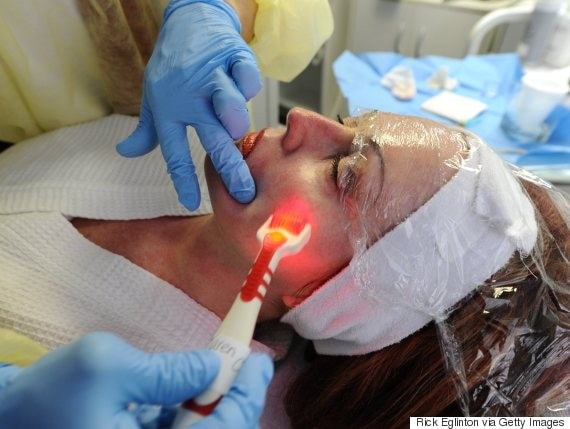
What Are The Risks Of At-Home Microneedling
We do like go-getters and DIYers, and we promote where possible being involved and being the owner of your skin care. However, there are instances where doing it yourself (“DIY”) results in “Destroying It Yourself). Microneedling should ideally be carried out by someone who has been trained, is actively working with a mentor, and is routinely involved in the practice and monitoring of skin undergoing this treatment. Also, attempting to use unqualified tools with uncertain needle lengths can be unsafe as you cannot control the depth of needles, increasing the risk of injury to you. If you do choose microneedling at home, be sure to purchase your supplies from trusted sources.
Attempting to self-microneedle using consumer-grade products can result in injury, unintentional transfer and propagation of bacteria and produce undesirable outcomes. When working together with a trained and certified microneedling expert, it is less likely that the end-results will be rushed.
Home microneedling should only be performed under the guidance and advice of a microneedling professional and with the use of recommended tools and products.
Home Microneedling vs. Medical Microneedling
The tiny needle size maintains shallow depths and works within the skin’s very top layer to improve the appearance of fine lines, wrinkles, and texture. In contrast, medical microneedling, which is performed by trained professionals in a clinical setting, utilizes microneedles ranging between .5 mm–2.5 mm, and is ideal for scar tissue and corrective work, deeper lines and wrinkles, and coarser skin types. Both home and medical microneedling help stimulate the skin’s natural production of regenerative proteins and upregulates enzymatic activity to optimize healthy cellular communication and absorption of topical nutrients.
What about other treatments like skin peels?
The skin community used to hold the position that the outer layer of skin is simply dead cells. This mindset has since change and we now believe the epidermis is a complex layer where chemical process still occurs. It is important to keep in mind that our collagen reduces by 1% every year from 26 years old. We should, therefore be interested in protecting the skin cells that we have and use them wisely. Skin peels should be performed by a trained professional, using products that have been approved for use and sale in Canada.
*Disclaimer: The information contained within is in no way intended to supplement or replace medical advice. The reader is encouraged to consult with a physician to answer any questions about their personal health.
Where the information in this article contradicts the referenced scientific research, the research shall supersede this blog. The reader is now informed that the science (documented research, clinical studies, observational studies and anecdotal reports) may change over time, and it is up to the reader to qualify the information and conduct their own fact-finding.
No guarantees are made as to the effectiveness or actual outcome of microneedling or Collagen Induction Therapy. All results vary from client to client.



